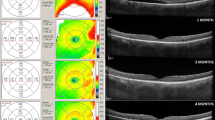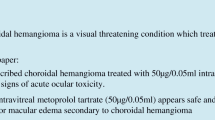Abstract
To evaluate the pituitary–adrenal axis function by means of the adrenocorticotropic hormone (ACTH) stimulation test following a single intravitreal injection of triamcinolone acetonide (IVTA). Prospective comparative clinical interventional study. Twenty-eight patients (28 eyes) received a single IVTA (4 mg in 0.1 ml) for macular edema. The basal cortisol level and the response to 1 μg adrenocorticotropic hormone stimulation were determined on the morning before IVTA injection and at 1 day and 1, 2, and 4 weeks after IVTA injection. Results were compared with those obtained from a control group of 50 healthy subjects. All patients in the study had normal basal cortisol and normal response to ACTH challenge before receiving IVTA. 1 day following IVTA, basal cortisol was suppressed in one patient in the study group. Fasting serum cortisol levels at 1, 2, and 4 weeks after IVTA injection were normal in all patients in the study group. 1 day following IVTA, the peak response to ACTH at 30 min was blunted in four patients (14.3 % of the study group, p = 0.05) and the cortisol response at 60 min was suppressed (p = 0.009). 1 week following IVTA, the response to ACTH challenge was blunted in only one patient. A single IVTA injection may be associated with impaired hypothalamic–pituitary–adrenal function in some patients during the first 24 h following IVTA.



Similar content being viewed by others
References
Feldman-Billard S, Lissak B, Kassaei R, Benrabah R, Heron E (2005) Short-term tolerance of pulse methylprednisolone therapy in patients with diabetes mellitus. Ophthalmology 112:511–515
Feldman-Billard S, Lissak B, Benrabah R, Kassaei R, Heron E (2003) Intravenous pulse methylprednisolone therapy in eye disease: effect on glucose tolerance. Ophthalmology 110:2369–2371
Schimmer BP, Parker KL (2006) Adrenocorticotropic hormone; adrenocortical steroids and their synthetic analogs; inhibitors of the synthesis and actions of adrenocortical hormones. In: Brunton LL, Lazo JS, Parker KL (eds) Goodman, gilman’s the pharmacological basis of therapeutics. McGraw-Hill, New York, pp 1587–1612
Doggrell SA (2001) Triamcinolone: new and old indications. Expert Opin Pharmacother 2:1177–1186
Jonas JB, Sofker A (2001) Intraocular injection of crystalline cortisone as adjunctive treatment of diabetic macular edema. Am J Ophthalmol 132:425–427
Schwartz SG, Flynn HW Jr (2007) Pharmacotherapies for diabetic retinopathy: present and future. Exp Diabetes Res 2007:52487
Danis RP, Ciulla TA, Pratt LM, Anliker W (2000) Intravitreal triamcinolone acetonide in exudative age-related macular degeneration. Retina 20:244–250
Jonas JB, Akkoyun I, Kamppeter B, Kreissig I, Degenring RF (2005) Intravitreal triamcinolone acetonide for treatment of central retinal vein occlusion. Eur J Ophthalmol 15:751–758
Park CH, Jaffe GJ, Fekrat S (2003) Intravitreal triamcinolone acetonide in eyes with cystoid macular edema associated with central retinal vein occlusion. Am J Ophthalmol 136:419–425
Chen SD, Lochhead J, Patel CK, Frith P (2004) Intravitreal triamcinolone acetonide for ischaemic macular oedema caused by branch retinal vein occlusion. Br J Ophthalmol 88:154–155
Kok H, Lau C, Maycock N, McCluskey P, Lightman S (1916) Outcome of intravitreal triamcinolone in uveitis. Ophthalmology 2005(112):e1911–e1917
Young S, Larkin G, Branley M, Lightman S (2001) Safety and efficacy of intravitreal triamcinolone for cystoid macular oedema in uveitis. Clin Exp Ophthalmol 29:2–6
Konstantopoulos A, Williams CP, Luff AJ (2008) Outcome of intravitreal triamcinolone acetonide in postoperative cystoid macular oedema. Eye 22:219–222
Benhamou N, Massin P, Haouchine B, Audren F, Tadayoni R, Gaudric A (2003) Intravitreal triamcinolone for refractory pseudophakic macular edema. Am J Ophthalmol 135:246–249
Dallman MF, Akana SF, Levin N, Walker CD, Bradbury MJ, Suemaru S, Scribner KS (1994) Corticosteroids and the control of function in the hypothalamo-pituitary-adrenal (HPA) axis. Ann N Y Acad Sci 746:22–31
Hikichi T, Kosaka S, Takami K, Ariga H, Ohtsuka H, Higuchi M, Matsushita T, Matsushita R (2010) Serum concentration of triamcinolone acetonide used for visualisation during vitrectomy. Br J Ophthalmol 94:1402–1403
Degenring RF, Jonas JB (2004) Serum levels of triamcinolone acetonide after intravitreal injection. Am J Ophthalmol 137:1142–1143
Nye EJ, Grice JE, Hockings GI, Strakosch CR, Crosbie GV, Walters MM, Jackson RV (1999) Comparison of adrenocorticotropin (acth) stimulation tests and insulin hypoglycemia in normal humans: low dose, standard high dose, and 8-hour acth-(1–24) infusion tests. J Clin Endocrinol Metab 84:3648–3655
Rasmuson S, Olsson T, Hagg E (1996) A low dose acth test to assess the function of the hypothalamic-pituitary-adrenal axis. Clin Endocrinol 44:151–156
Lang Y, Zemel E, Miller B, Perlman I (2007) Retinal toxicity of intravitreal kenalog in albino rabbits. Retina 27:778–788
Martidis A, Duker JS, Greenberg PB, Rogers AH, Puliafito CA, Reichel E, Baumal C (2002) Intravitreal triamcinolone for refractory diabetic macular edema. Ophthalmology 109:920–927
Martidis A, Duker JS, Puliafito CA (2001) Intravitreal triamcinolone for refractory cystoid macular edema secondary to birdshot retinochoroidopathy. Arch Ophthalmol 119:1380–1383
Wilson CA, Berkowitz BA, Sato Y, Ando N, Handa JT, De Juan E Jr (1992) Treatment with intravitreal steroid reduces blood-retinal barrier breakdown due to retinal photocoagulation. Arch Ophthalmol 110:1155–1159
Zaka-ur-Rab S, Mahmood S, Shukla M, Zakir SM, Khan BA, Owais M (2009) Systemic absorption of triamcinolone acetonide after posterior sub-tenon injection. Am J Ophthalmol 148:414–419
Shen L, You Y, Sun S, Chen Y, Qu J, Cheng L (2010) Intraocular and systemic pharmacokinetics of triamcinolone acetonide after a single 40-mg posterior subtenon application. Ophthalmology 117(12):2365–2371
Kuo CH, McCluskey P, Gillies M (2010) Pharmacotherapeutic efficacy of preservative-free intravitreal triamcinolone acetonide. Expert Opin Pharmacother 11:155–166
Khani S, Tayek JA (2001) Cortisol increases gluconeogenesis in humans: its role in the metabolic syndrome. Clin Sci 101:739–747
Oltmanns KM, Dodt B, Schultes B, Raspe HH, Schweiger U, Born J, Fehm HL, Peters A (2006) Cortisol correlates with metabolic disturbances in a population study of type 2 diabetic patients. Eur J Endocrinol 154:325–331
Habib GS (2009) Systemic effects of intra-articular corticosteroids. Clin Rheumatol 28:749–756
Sim D, Griffiths A, Armstrong D, Clarke C, Rodda C, Freezer N (2003) Adrenal suppression from high-dose inhaled fluticasone propionate in children with asthma. Eur Respir J 21:633–636
Ebner R, Devoto MH, Weil D, Bordaberry M, Mir C, Martinez H, Bonelli L, Niepomniszcze H (2004) Treatment of thyroid associated ophthalmopathy with periocular injections of triamcinolone. Br J Ophthalmol 88:1380–1386
Ozerdem U, Levi L, Cheng L, Song MK, Scher C, Freeman WR (2000) Systemic toxicity of topical and periocular corticosteroid therapy in an 11-year-old male with posterior uveitis. Am J Ophthalmol 130:240–241
Chin HS, Park TS, Moon YS, Oh JH (2005) Difference in clearance of intravitreal triamcinolone acetonide between vitrectomized and nonvitrectomized eyes. Retina 25:556–560
Schindler RH, Chandler D, Thresher R, Machemer R (1982) The clearance of intravitreal triamcinolone acetonide. Am J Ophthalmol 93:415–417
Karaca Z, Lale A, Tanriverdi F, Kula M, Unluhizarci K, Kelestimur F. The comparison of low and standard dose acth and glucagon stimulation tests in the evaluation of hypothalamo-pituitary-adrenal axis in healthy adults. Pituitary
Conflict of interest
No authors have any financial or conflicting interests to disclose
Author information
Authors and Affiliations
Corresponding author
Rights and permissions
About this article
Cite this article
Amiran, M.D., Yeung, S.N., Lang, Y. et al. Hypothalamic–pituitary–adrenal axis function following intravitreal triamcinolone acetonide injection. Int Ophthalmol 33, 211–216 (2013). https://doi.org/10.1007/s10792-012-9659-5
Received:
Accepted:
Published:
Issue Date:
DOI: https://doi.org/10.1007/s10792-012-9659-5




